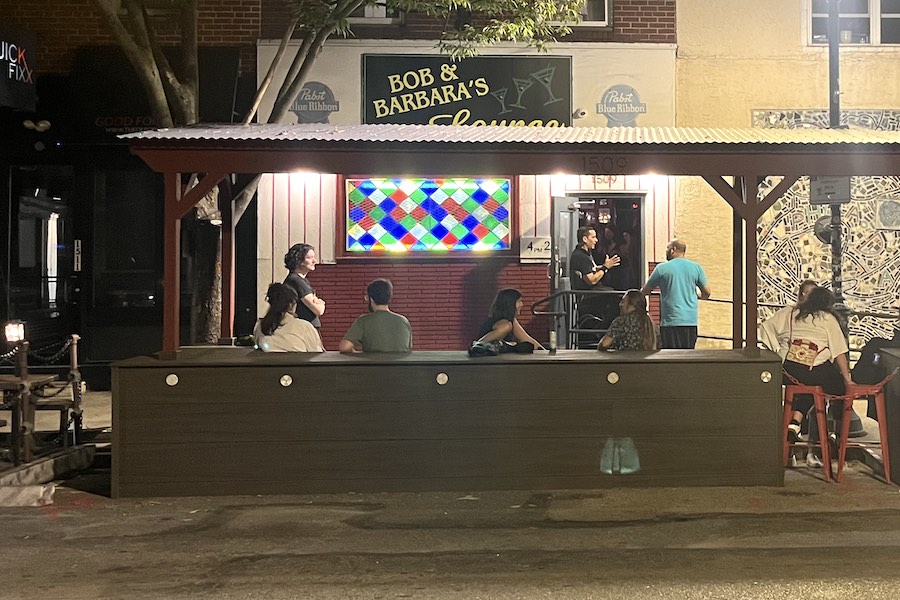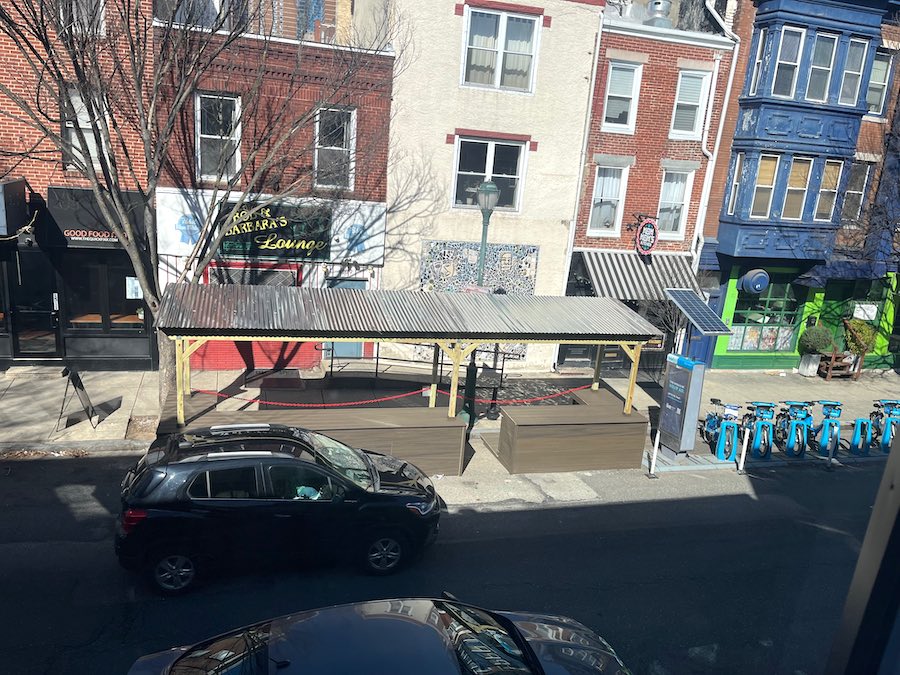Inside Bob & Barbara’s Streetery Nightmare
The iconic Philly dive bar learns that you really can't fight City Hall.

Philadelphia dive bar Bob & Barbara’s and its streetery. (Photo courtesy Bob & Barbara’s)
Like so many Philadelphia bars and restaurants, iconic South Street dive bar Bob & Barbara’s set up a streetery and other outdoor seating options during the COVID pandemic, giving themselves and their customers a life line after the city restricted indoor gatherings.
In the early days, the city was fairly lax in terms of streetery eligibility and construction. But then, in October 2022, the city released a 24-page PDF called “Philadelphia Streetery License Guide V 1.0.” The instructions contained all kinds of rules and restrictions. The booklet included lots and lots of measurements, diagrams, and lists of do’s and don’ts. There was now a formalized process to determine eligibility and gain streetery approval.
Bob & Barbara’s operator Oskar Duva says he read the book from beginning to end many times over. And he came up with a general idea for what the new Bob & Barbara’s Streetery would be. Then he worked with an engineering firm to produce the design, which included reinforced concrete crash barriers built into its outer shell. The bar submitted highly detailed drawings to the city. Throughout 2023, Duva went through the tedious and endlessly bureaucratic process of approvals and permits. “We got approval from the Art Commission,” he recalls. “Then the Streets Department. We got the building permits we needed. And we got a streetery license.”
Bob & Barbara’s jettisoned its original, makeshift streetery. And in early March 2024, just in time for St. Patrick’s Day, Bob & Barbara’s debuted its new streetery. It thrived, and hosted throngs of imbibers. But then the phone at Bob & Barbara’s rang in May. On the other end of the line was a contractor working for the city. He told Duva that Bob & Barbara’s had to remove its streetery for a paving project.
“I told him we hadn’t heard anything from the city about any paving project or moving the streetery,” Duva says. “It was a ridiculous ask, to up and move it right after we put it up. And due to the complicated design, which, again, the city approved, we couldn’t just move it. The contractor suggested he’d be happy to pave around it — if the city was OK with that.”
The contractor put Duva in contact with someone from the city. But Duva says the city just bounced him around. And on June 6th, he found an order taped to the streetery. The order said the bar had to remove the streetery by June 30th. “No one at the city was willing to have any kind of a conversation,” he tells Philly Mag. “No one wanted to discuss a compromise. So we had no choice but to hire a lawyer.”
It turned out that the city published a new guide, “Philadelphia Streetery License Guide V 1.1,” in February 2024, just before Bob & Barbara’s was set to debut its streetery and well after various city agencies had approved that detailed design. And in this updated version of the streetery guide, there was one major difference as it applied to Bob & Barbara’s: You had to be able to remove the streetery within 48 hours.
(The actual city code on which both guides were based apparently did mention the 48-hour rule as early as October 2022, but Duva says he didn’t read the code, instead basing the design solely on the V 1.0 instructions published by the city, which didn’t explain the 48-hour requirement. After all, says Duva, he thought the whole point of the in-depth instructions was that they would serve as, well, instructions.)

Another view of the Bob & Barbara’s streetery on South Street (photo courtesy Bob & Barbara’s)
Duva says he never would have gone with the design he chose had he known this from the outset, because the approved design makes it extremely difficult to just move the streetery somewhere. He also doesn’t understand why the city would approve such a streetery if it had known that it was going to soon be paving the very street where the streetery was to sit — or why somebody didn’t think to mention the paving until months after the streetery had been approved and erected. (A Philadelphia Streets Department employee who asked not to be named insists to Philly Mag that the department knows about paving projects like the one on South Street “years” in advance.)
The bar tried to deal with this agency and that agency but got nowhere. They filed for an appeal but couldn’t even get an appeal hearing. Then they filed for an emergency injunction to prevent the city from forcing the removal of their streetery. Duva and his family (Bob & Barbara’s is a family-owned-and-operated establishment) showed up in a city courtroom on Friday, September 13th, for a hearing on that emergency injunction and pleaded the bar’s case. But it was no use. Last week, the judge decided in the city’s favor and this coming weekend will be the last for the Bob & Barbara’s streetery.
“If they said originally that our streetery had to be designed so that it could be removed within 48 hours, we wouldn’t be here right now,” says Duva. “If they had told me that they were going to repave South Street in 2024, we wouldn’t be here right now. So based on where we’re at, we’re probably not going to have a streetery in the future. We have to junk this one. A lot of the materials wouldn’t be useful in a new streetery design based on what we know now. And because we’d need an entirely new design, since the approved one can’t be moved at a moment’s notice, we’d have to start the entire design and approval process from scratch.”
Duva says the bar, which is well known for having some of the cheapest prices in the city, is out $35,000 on design and construction fees. Then there’s all those permitting fees. Legal fees spent trying to fight the city. And, now, the cost to demolish and junk the streetery. Duva says the whole process is costing the bar well over $50,000. The City Controller’s office recently issued a report indicating many problems with the city’s streetery program.
“The city does not have a good record of working with small businesses, and this is a good example of that,” Duva observes. “We pay a lot of money in taxes every year, all kinds of fees. And we’re just doing our best to stay in business right now. Since 2020, all of our expenses have gone up. And the streetery was a way for us to make up for that. People like sitting outside. So now to have that thrown back in our face … that’s a pretty tough blow. But we’re going to keep doing our thing.”


